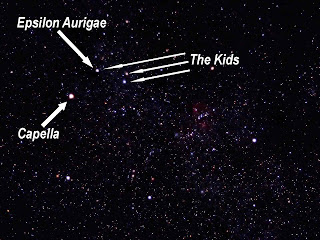
Tony Martinez

It is 2009, and this is the “International Year of Astronomy.” I will keep you informed about any special events in our area, however, you should check out the official website for all the events of the year; http://www.astronomy2009.org/.
I always feel compelled to use an image of the beautiful constellation Orion in any January Astronomy column. It graces our sky every winter and yields beautiful sights for the naked eye, binoculars, and on up to large amateur telescopes. To get a good overview of this constellation, please refer back to my column of January 2008.

Hopefully some of you got your first telescope for Christmas, or maybe some new astronomy accessories. So I will use my column to give an overview of what sights are ahead for 2009.
January: Venus will continue to climb high in the western sky after sunset. If you would like a challenge, try to spot the asteroid Ceres as it glides through the constellation Leo throughout the next few months. Next month I will help out with more information about Ceres.
 February: Try to locate the new comet, Lulin. Like any new comet, it may be very dim, or become quite bright; we shall see. A good time to try for the comet is around February 22nd and 23rd, as it passes under the planet Saturn. The following image shows the comet on the 23rd; the red circle is the view with seven power binoculars.
February: Try to locate the new comet, Lulin. Like any new comet, it may be very dim, or become quite bright; we shall see. A good time to try for the comet is around February 22nd and 23rd, as it passes under the planet Saturn. The following image shows the comet on the 23rd; the red circle is the view with seven power binoculars.March: Saturn will be at its brightest on March 8th in the southeast. I suggest you check it out with your telescope to see how Saturn’s rings appear when they are tipped towards us. Throughout this year, the rings are tipped toward us. This happens about twice in the nearly thirty years it takes for Saturn to make one trip around the Sun.
April: Did you miss Mercury at the end of December 2008? If so you have an even better chance from mid to late April. For a special treat, check out the southwest between 7-7:30 PM to see the crescent moon with the Pleiades directly underneath, and Mercury under the Pleiades!
May: If you are a fan of planet watching, and are an earlier riser, there will be five planets in the eastern sky between 4 and 5 AM toward the end of May: Mars, Venus, Uranus, Neptune and Jupiter.
June: The return of the wonderful constellations of summer, Scorpius and Sagittarius. Within and above these two constellations is a wealth of great deep sky objects.
July: Did you ever want to visit the Far East? If so, choose July 22nd. An extremely long total solar eclipse, more than 6 minutes, will move through northern India and central China. If you prefer not to travel that far, then put August 21st, 2017 on your calendar, and you will get a total solar eclipse right here in South Carolina for 2 minutes and 40 seconds.
August: Jupiter is at its brightest this year on August 14. Go for a view of the “surface” bands with your telescopes.
September: Auriga is actually a late Fall to Spring constellation, and contains an interesting triangle asterism called the “Kids.” Starting this August, the top star of this triangle, Epsilon Aurigae will darken for almost two years. No one is sure what is causing this uniquely long eclipse. Check out the Kids this spring, and then notice the change in September; you will have to stay up late. Another approach is to observe Auriga and the Kids this spring on a regular, if not nightly basis. Once you become overly familiar with this constellation, the eclipse of Epsilon Aurigae will become obvious throughout this fall and winter.
October: Want to get up early again? On October 13th, Venus will pass just to the right of Saturn; best view between 5 and 6 AM.
November: This month’s claim to fame is the sometimes great Leonids meteor shower, which will peak on November 17th, right after a new Moon. As you may recall, last year, it peaked with a full Moon, which of course washed out the entire shower.
December: If the Leonids fail to impress this year, try for the Geminids meteor shower, peaking on December 14th, again without any interference from the Moon. Although seldom mentioned, the Geminids have the potential of being the best meteor shower on any given year, so check it out.
So that’s the year 2009. During my columns throughout the year, I will give more details of the various astronomical events listed above.
Naked Eye Sights:
Orion of course, and the bright Venus.
Binocular Sights (7 to 10 power):
The Pleiades.
Telescope Sights (60-100mm):
This year, aim again at the center “star” of Orion’s sword, the Orion nebula. From 25 power and above, you can see the gaseous nature of the Orion nebula. A special challenge is to try to see the four young stars in the center of the nebula known as the Trapezium. You may have to go up to about 50 power to easily spot them deeply imbedded in the center of the nebula. This image may help.

See you next month, and have a good year of viewing.

